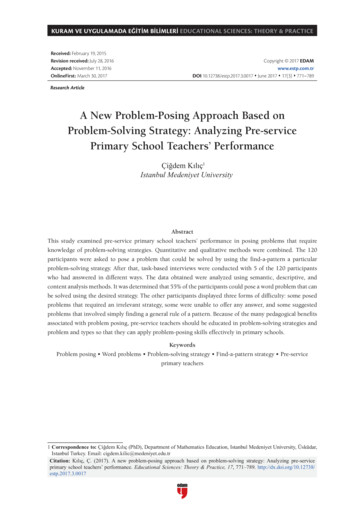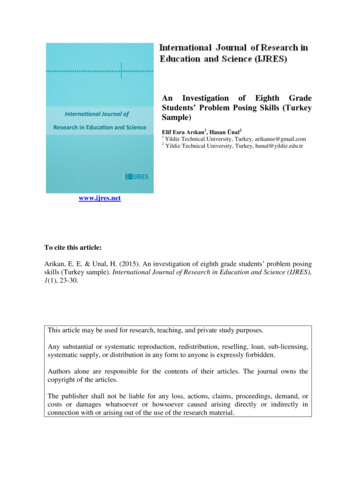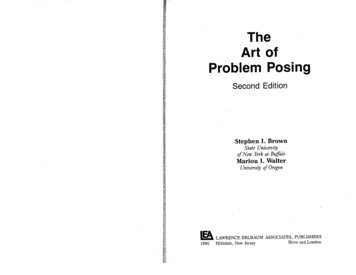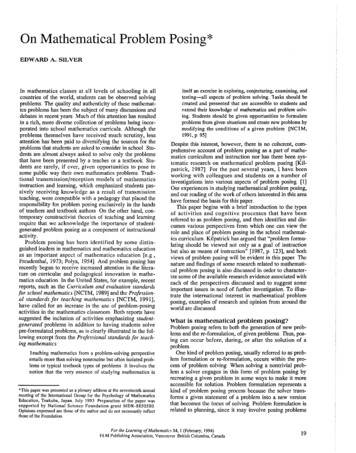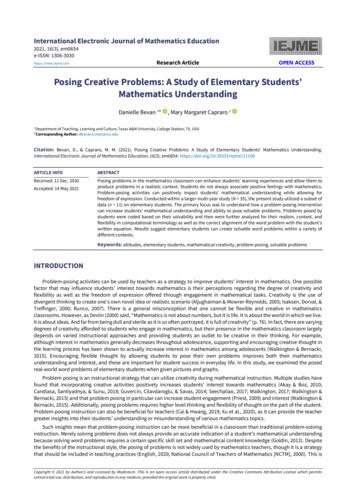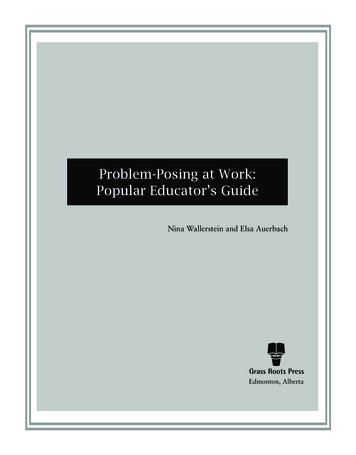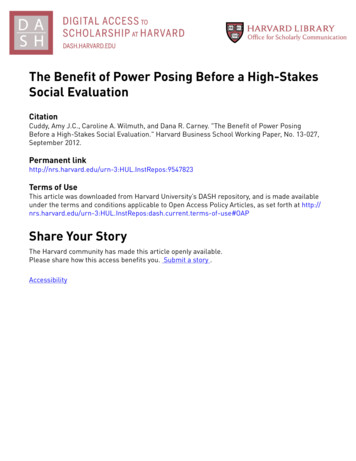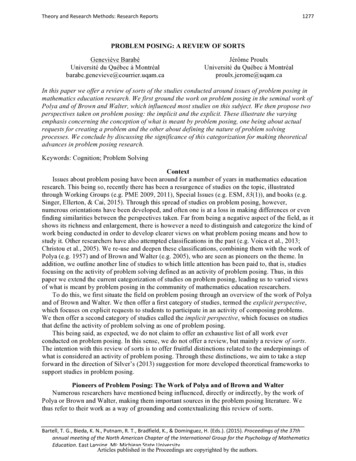
Transcription
!!PROBLEM POSING: A REVIEW OF SORTSGeneviève BarabéUniversité du Québec à Montréalbarabe.genevieve@courrier.uqam.caJérôme ProulxUniversité du Québec à Montréalproulx.jerome@uqam.caIn this paper we offer a review of sorts of the studies conducted around issues of problem posing inmathematics education research. We first ground the work on problem posing in the seminal work ofPolya and of Brown and Walter, which influenced most studies on this subject. We then propose twoperspectives taken on problem posing: the implicit and the explicit. These illustrate the varyingemphasis concerning the conception of what is meant by problem posing, one being about actualrequests for creating a problem and the other about defining the nature of problem solvingprocesses. We conclude by discussing the significance of this categorization for making theoreticaladvances in problem posing research.Keywords: Cognition; Problem SolvingContextIssues about problem posing have been around for a number of years in mathematics educationresearch. This being so, recently there has been a resurgence of studies on the topic, illustratedthrough Working Groups (e.g. PME 2009, 2011), Special Issues (e.g. ESM, 83(1)), and books (e.g.Singer, Ellerton, & Cai, 2015). Through this spread of studies on problem posing, however,numerous orientations have been developed, and often one is at a loss in making differences or evenfinding similarities between the perspectives taken. Far from being a negative aspect of the field, as itshows its richness and enlargement, there is however a need to distinguish and categorize the kind ofwork being conducted in order to develop clearer views on what problem posing means and how tostudy it. Other researchers have also attempted classifications in the past (e.g. Voica et al., 2013;Christou et al., 2005). We re-use and deepen these classifications, combining them with the work ofPolya (e.g. 1957) and of Brown and Walter (e.g. 2005), who are seen as pioneers on the theme. Inaddition, we outline another line of studies to which little attention has been paid to, that is, studiesfocusing on the activity of problem solving defined as an activity of problem posing. Thus, in thispaper we extend the current categorization of studies on problem posing, leading us to varied viewsof what is meant by problem posing in the community of mathematics education researchers.To do this, we first situate the field on problem posing through an overview of the work of Polyaand of Brown and Walter. We then offer a first category of studies, termed the explicit perspective,which focuses on explicit requests to students to participate in an activity of composing problems.We then offer a second category of studies called the implicit perspective, which focuses on studiesthat define the activity of problem solving as one of problem posing.This being said, as expected, we do not claim to offer an exhaustive list of all work everconducted on problem posing. In this sense, we do not offer a review, but mainly a review of sorts.The intention with this review of sorts is to offer fruitful distinctions related to the underpinnings ofwhat is considered an activity of problem posing. Through these distinctions, we aim to take a stepforward in the direction of Silver’s (2013) suggestion for more developed theoretical frameworks tosupport studies in problem posing.Pioneers of Problem Posing: The Work of Polya and of Brown and WalterNumerous researchers have mentioned being influenced, directly or indirectly, by the work ofPolya or Brown and Walter, making them important sources in the problem posing literature. Wethus refer to their work as a way of grounding and contextualizing this review of oceedings of the 37th annual meeting of the North American Chapter of the International Group for the Psychology of Mathematics sity.!
!!George Polya’s Problem PosingPolya’s (e.g. 1957) work on problem solving focuses on helping and pushing students to analysethe problems they solve and to think of other interesting problems in relation to them. In so doing, forPolya, teachers help students to consolidate their knowledge, develop their ability to solve problemsand improve their solution or their understanding of it. Polya did not used the expression problemposing in his work, referring mostly to what he called the Looking back technique, which enablesstudents to generate new ideas and investigate possible connections between mathematical problems.Having solved a problem, students are asked to look at what they have done and then to formulatenew problems out of it. Polya argues that through this activity, students gain a better understandingof their solutions and increase their solving abilities. To formulate new problems, Polya suggestsvarious heuristics of Looking back, four of which are discussed here. For example, consider thisproblem for students to solve (Figure 1):Figure 1: Polya’s parallepiped problem (Polya, 1957, p. 7)A first heuristic consists, once one knows the solution to this problem, of generating analogousproblems, i.e. similar problems to this one. Polya gives examples of possible formulations: “a) Giventhe three dimensions of a parallelepiped, find the radius of the circumscribed sphere; b) The base of apyramid is a rectangle of which the center is the foot of altitude and the sides of its base, find thelateral edges; c) Given the rectangular coordinates (x1, y2, z3), (x1, y2, z3) of two points in space, findthe distance of these points.” (1957, p. 66) These problems allow students to go back to the initialsolution, but for other contexts, which requires them to rethink the solution and not only apply theformula. A second heuristic consists of applying the formula found by modifying the problem and itsdata. For example, the initial problem requires looking for the diagonal of the parallelepiped inrelation to its width, length, and height. Another problem can be formulated by asking to find theheight of the parallelepiped depending on the diagonal, the length, and the width. This heuristicrequires interchanging the role of the various givens of the problem. Polya’s third heuristic isgeneralizing/specifying. Generalizing consists in solving the same problem, but for an entire categoryof numbers or givens. For the above problem, one possible generalization could be: “Find thediagonal of a parallelepiped, being given the three edges issued from an end-point of the diagonal,and the three angles between these three edges.” (1957, p. 67), which requires e.g. aiming foralgebraic letters to represent the needed values of the problem. Also, a way of specializing theproblem would be to look for specific cases, like finding the diagonal of a cube knowing one of itsedges. A fourth heuristic is studying variations, that is, studying the effect of varying some of thedata in the problem. For example, in the analogous problem of the circumscribed sphere, one canvary the radius of the sphere and study its effect on the problem and solution, leading to threepossible cases: the sphere is entirely contained in the cube, the sphere is circumscribed in the cube;and finally the sphere encompasses the cube. Polya’s heuristics are illustrations of his Looking backapproach. For him, binding problem posing to problem solving allows students to see the possiblemathematical connexions between various problems. By looking back at their solution, byreconsidering and examining the solution and the path they have followed, he argues that studentsconsolidate their knowledge and develop their problem solving roceedings of the 37th annual meeting of the North American Chapter of the International Group for the Psychology of Mathematics sity.!
!!Brown and Walter’s Problem PosingThe main goal of Brown and Walter’s (e.g. 2005) problem posing is to study mathematics byworking on students’ questions and reflections on a given topic. For Brown and Walter, questionsthat arise in the classroom must not only be instrumental (i.e. posed to ensure understanding andperformance of what the teacher asks students to do), but rather should help student to develop theirmathematical skills, understanding and autonomy. In The Art of Problem Posing, Brown and Walterpresent two perspectives of problem posing: Accepting and What-if-not? (WIN). These perspectivesare to help teachers to develop strategies for using problem posing in class with their students. TheAccepting perspective refers to students accepting a concept suggested by the teacher (e.g. theconcept of prime numbers defined as natural numbers that have exactly two natural divisors), andthen finding interesting problems/questions about it. In the case of prime numbers, it could bequestions like: How many prime numbers are there? How to find the next prime number? They arguethat this leads students to explore and work mathematically on a concept, in order to develop anunderstanding of it.The WIN perspective consists, on the other hand, in seeing what happens when instead of“accepting” the concept, one contests its characteristics. Brown and Walter suggest various levels ofWIN, which they illustrate with the example of the Pythagorean theorem. A first level is for studentsto list the attributes of the Pythagorean theorem. For example, it may be noted that all number aresquared or that the variables are connected by an equal sign. A second level consists of asking a WINquestion for each of the attributes listed. For example, What-if the variables were not connected by anequal sign, but by an inequality? This question opens and becomes a new route to be explored forboth students and teacher. A third level, called the What-if-Not-ing level, requires combining thenegation of two of the attributes listed. In this case, it could be by looking at what happens when thevariables are not linked by an equal symbol and all numbers are not squared. This also opens a newroute to explore. For Brown and Walter, these mathematical explorations allow students tounderstand the Pythagorean theorem through the importance of its mathematical attributes, as well asdeveloping their ability to formulate questions, explore mathematics, and solve problems. In thissense, the authors argue that after solving a problem, a person does not fully understand the meaningof what he/she has done unless new interconnected problems are formulated and analyzed, whichaffords a better grasp of the concept worked on. Thus Brown and Walter’s problem posing is relatedto an inquiry process that leads to the exploration of concepts for understanding them better, arguingalso for openness toward mathematical questions and thoughts that occur in classrooms.Conceptualizing Problem Posing: Explicit and Implicit PerspectivesGrounded or not in Polya or in Brown and Walter’s ideas, various meanings about problemposing are found in the literature. We distinguish these meanings by suggesting two perspectives.The explicit perspective refers to an explicit request for students to compose problems, whereas theimplicit perspective refers to something that occurs implicitly in the activity of problem solving, i.e.every act of problem solving is seen as an activity of problem posing in itself.The Explicit Perspective: A Pragmatic View of Problem PosingIn the explicit perspective, we distinguish three categories of studies being conducted,highlighting their diverse but complementary nature. We discuss these and give examples for each ofthem. In our description, we use the word learners to refer whether to students or (prospective)teachers who are doing the various kinds of problem posing.Category 1: To compose a problem without any context or constraint. This first categoryrefers to asking learners to compose a problem without imposing any context or constraints. In short,they need to compose from scratch. This category of problem posing can be linked to whatStoyanova and Ellerton (1996) call a free problem posing situation where students have to !Proceedings of the 37th annual meeting of the North American Chapter of the International Group for the Psychology of Mathematics sity.!
!!new problems in an open situation. For their part, Christou et al. (2005) refer to this kind of problemposing as tasks that require students to pose a problem in general, in free situations. In this category,we find, for example, the work of Ellerton (1986) and of Crespo (2003). In her work, Ellerton asksstudents to compose a problem that would be difficult, a challenge, for a friend to solve. The studentsthen have a blank card to compose mathematical problems of any kind related to the concepts thatthey wish. In Crespo’s study, elementary students are paired with prospective teachers andcorrespond one-on-one by sending each other letters. Through this, Crespo aims at placingprospective teachers in an authentic experience of generating problems by asking them to writemathematical problems in their letters for their elementary student. The prospective teachers have noconstraints on the type of problem to compose or the mathematical concepts to use.Category 2: To generate problems from specific constraints. Another category refers toasking learners to generate problems on the basis of specific constraints. Many, if not most, studiesconducted on problem posing can be placed in this category. In fact, this category can even besubdivided into three subcategories covering the constraints given to learners for generatingproblems: (a) generate from a general context; (b) generate from specific constraints; (c) generatefrom a previously solved problem.The generate from a general context subcategory contains studies that ask learners to generate aproblem in a general context. Brown and Walter’s (e.g. 2005) Accepting perspective of problemposing is an example of this. In the example given above about Accepting, the context is the primenumbers, which are introduced to students who then have to generate problems about thismathematical concept without other indications. Work conducted by English (1998) is also of thistype, where students have to compose problems in an informal mathematical context free of symbolicrepresentation. For example, she asks students to make up a story problem about what they see in alarge photograph of children playing with a set of brightly coloured items. A general mathematicalcontext is then given to learners who have to generate problems from it. The subcategory generatefrom specific constraints refers to studies that ask learners to generate problems within or in relationto specific constraints. Silver (1994) refers to this subcategory as problem generation, where the goalis the creation of new problems from a situation prior to any problem solving. This subcategory canalso be linked to what Christou and al. (2005) call a task that requires students to pose a problemwith a given answer, a problem that contains certain information, a question for a problem situation,or a problem that fits a given calculation. Brown and Walter’s (e.g. 2005) WIN perspective, asdiscussed above, takes place in this subcategory as it asks students to generate problems based on ainitial mathematical situation using the WIN technique. The WIN technique is seen here as aconstraint because it gives insight into the kind of problem students have to generate. Lavy’s works(Lavy and Bershadsky, 2003; Lavy and Shriki, 2007), using the WIN technique in class withprospective teachers in a geometry context, is another example of this subcategory. We can also referto studies of Silver and Cai (1996) and Silver, Mamona-Downs, Leung and Kenney (1996), in whichbefore solving a mathematical task, students are asked to compose three problems that can be solvedfrom the information/data given in an initial problem. When they have composed a new problembased on this one, students are asked to solve eight related problems. The researchers then studied thenature of the composed problems and the relationship between their ability to compose and to solveproblems. This kind of problem posing contrasts with the other subcategories because the specificconstraints (the technique or the problem) guide the kind of problem that learners would be morelikely to compose. The last subcategory, generate from a previously solved problem, contains studiesasking learners, after having solved a specific problem, to create other problems based on this solvedproblem. The problems then created are modifications of the goals or the conditions of the previouslysolved problem. Silver et al. (1996) above mentioned study is also in this subcategory, where inanother part of their study students have to generate a problem from previously solved ones. !Proceedings of the 37th annual meeting of the North American Chapter of the International Group for the Psychology of Mathematics sity.!
!!(e.g. 1957) heuristics of the Looking back technique (analogies, modifying, generalizing-specifyingand studying variations) are also examples of this.Category 3: To transform an initial problem. The third category of problem posing isintricately linked to problem solving strategies, as it contains studies that ask learners to transform aninitial problem in order to solve it. This kind of problem posing occurs during the problem solvingprocess, when students are invited, as an efficient solving strategy, to reformulate for themselves thegiven problem. For example, strategies given to students are to decompose the problem into subproblems, to simplify or modify the original problem or to solve a related problem. Students usethese strategies to achieve one goal: to be able to solve the original problem. The problem posing isthen seen as a means of solving the given problem. Silver (1994) refers to this category of problemposing as occurring during the process of solving when students must ask themselves “How can Iformulate this problem so that it can be solved?” (p. 20). Kilpatrick (1987) mentions that problemposing consists of reformulating an existing problem in order to make it one’s own; seeing problemposing (what he calls problem formulating) as an important companion to problem solving. Mason,Burton and Stacey’s (1982) Thinking Mathematically book explains this approach in detail to helplearners solve a problem. In a similar vein, Polya’s (1966) video on Guessing amply illustrates thiscategory of problem posing. In the video, Polya tells his students that if a problem is too difficult tosolve, they should pose easier sub-problems, which could prepare them to solve the bigger problem;examples explored are to consider the problem in 2D instead of 3D, reducing the number ofconstraints/givens in the problem, and so forth. The aim is that, as they solve these sub-problems,learners gain a better sense of the original problem and prepare themselves for solving it.The Implicit Perspective: An Epistemological View of Problem PosingStudies under what we term the implicit perspective are less frequently, if ever, accounted for inreviews on problem posing. In this perspective, we integrate studies that conceptualize the problemsolving process as events of problem posing. Thus whereas in the first perspective the notion ofproblem posing was related to explicit requests for creating problems through varied contexts, in thissecond perspective the notion of problem posing happens implicitly, without any request, as it definesthe activity of problem solving itself. In various ways, work conducted under this lens makes theargument that when students solve problems, they are in fact posing their own problems, as we showbelow.Category 1: Problem posing that influences the problem solving path. This categorycomprises studies that focus on the link between problem posing and problem solving, emphasizingthe influence of the posed problems on the solving process. The work of Sevim and Cifarelli (2013)illustrates this. They argue that when solving a problem, a solver creates his/her own goals andpurposes. These change as the solver progresses in the solution and also indicate the path of solvingthat the solver chooses. Armstrong’s (2013) work is another example of this, as she records andstudies students’ questions that arise while they are solving a problem, and which influences thecourse of the solving. In her work, she looks at the questions that a group of students workingtogether ask themselves when solving a task. For example, students would ask questions like “Whatis meant by an interval?” “Is it a square root?” or “What if there are x people?” (p. 67), in order tothink about the task and arrive at a solution. Each group of students asks different or similarquestions, and some groups also ask questions more than once during the same problem solvingprocess. Armstrong made a “tapestry” schema out of this that shows the problem posing pathfollowed by each group when solving their problem. She illustrates that the process used by learnersdirectly influences their problem solving process. Stoyanova and Ellerton (1996) definition ofproblem posing, “the process by which, on the basis of mathematical experience, students constructpersonal interpretations of concrete situations and formulate them as meaningful mathematicalproblems” (p. 518), can be linked to this implicit problem posing. In order to solve a Proceedings of the 37th annual meeting of the North American Chapter of the International Group for the Psychology of Mathematics sity.!
!!learners formulate for themselves meaningful problems on the basis of their mathematicalexperience; this is not done as a request or as a strategy for solving, but mainly reflects what they do,their solving processes.Category 2: Gaps between teachers’ and students’ task. Researchers like Perrin-Glorian,Robert and Rogalski (see e.g. Perrin-Glorian & Robert, 2005; Robert & Rogalski, 2002; Rogalski,2003) have also worked along those lines to develop meaning about students’ problem solvingprocesses. Like Polya, they have not used the expression problem posing, but have focused onstudents’ interpretations of the problems given to them, where they formulate for themselves, theypose, what the problem to be solved is. Rogalski (2003) identified various natures that tasks canassume when presented by teachers in the classroom, all of this happening implicitly during theactivity of problem solving. First, the teacher prescribes a task to students, which consists essentiallyin the formulation of the problem. This prescribed task may be directly observed, as it consists of theinstructions presented by the teacher to the students. The teacher has expectations about the task thatthe students have to work on: this is the expected task. On the other hand, students do not necessarilywork on the teachers’ prescribed task, but on one that has been redefined from that prescribed task.The redefined task, therefore, represents the student's personal representation of the task; somehowhis/her implicit posing of the task in his/her own terms. Finally, the effective task is the actual one towhich the student responds, which is not necessarily identical to the one he/she thinks he/she isresponding to; this leads to a dynamical interrelation between the redefined and effective task. Theseredefined and effective tasks illustrate the problem that the student actually asks/poses him/herselfand intends to solve (again, all of this happening implicitly in the solving process). The studiesconducted within this framework focus on the gaps between teachers’ expectations and students’mathematical activity in solving problems, their problem posing process.Category 3: Problem posing versus problem solving. Work in this third category is related toVarela’s (1996) epistemological definition of problem posing, which he contrasts with problemsolving. For Varela, problem solving implies that problems are already in the world, independent ofus, waiting to be solved. Varela explains, on the contrary, that we specify the problems that weencounter through the meanings we make of the world in which we live, leading us to recognizethings in specific ways. We do not choose problems that are out there in the world independent of ouractions. Rather, we bring problems forth, we pose them: “The most important ability of all livingcognition is precisely, to a large extent, to pose the relevant questions that emerge at each moment ofour life. They are not predefined but enacted, we bring them forth against a background.” (p. 91).The problems that we encounter, the questions that we ask, are thus as much a part of us as they are apart of our environment: they emerge from our interaction with/in it. The problems that we solve arerelevant for us as we allow them to be problems. Working in this perspective, René de Cotret (1999)notes that one cannot assert that instructional properties are present in the tasks presented and thatthese causally determine solvers’ reactions. As Simmt (2000) explains, it is not tasks that are given tostudents, but mainly prompts that are taken up by students who themselves create tasks with. Promptsbecome tasks when students engage with them, when, as Varela would say, they pose them asproblems. This posing, as we show in Proulx (2013) about mental mathematics contexts, determinesthe task solved, hence the strategy developed for it. Students make the “wording” or the “prompt” amultiplication task, a ratio task, a function task, an algebra task, and so forth, and solve accordingly,which leads to varied strategies and answers because they often start from “different” posedproblems.In this implicit perspective, students play an important role in what the problem to solve is: notbecause they have created it, but because a student is always solving his/her own problem, from agiven prompt. In this sense it is implicit, that is, it is not an explicitly requested task by someoneexternal to the student (as in the first explicit perspective), but something implicit in the solvingprocess when students engage with the(ir) problem to be solved. In sum, they implicitly create ings of the 37th annual meeting of the North American Chapter of the International Group for the Psychology of Mathematics sity.!
!!problem in the action of solving the problem; whereas in the first explicit perspective they wereexplicitly asked to create a problem from various context and data given. Both perspectives and theircategories are summarized in Table 1.Table 1. Summary of Implicit and Explicit PerspectivesExplicit perspective on problem posing(as an explicit request to learners)To compose a problem without any context orconstraintTo generate problems from specific constraintsTo transform an initial problem in order to solve itImplicit perspective on problem posing(as defining the problem solving process)Problem posing that influences the problemsolving pathGaps between teachers’ and students’ tasksProblem posing versus problem solvingFinal Remarks on these Categorizations of Problem PosingWhat do we learn from this? This categorization of work conducted on problem posing is morethan a review: it is an extension of the field. By integrating the work under the implicit perspective,which we have seldom encountered in reviews and activities about problem posing (WorkingGroups, books, Special Issues), we extend what are normally considered as studies in problem posingby opening the way to epistemological considerations about students’ mathematical activities.Whereas problem posing as a field is widely known in terms of an activity to plunge students into, asa teaching device or as a strategy for solving problems (see e.g. Voica et al, 2013; Christou et al.,2005), what we have grouped under the implicit perspective is much less known and tacklesepistemological issues related to students mathematical activity in itself. Epistemologicalquestions/issues are not new in problem posing work, as some of them can be seen and felt throughthe work of Stoyanova and Ellerton (1996) and of Kilpatrick (1987), however they oscillate betweena view of problem posing as a request on students and as representing students’ mathematicalactivity. The distinction offered here between explicit requests for problem posing and the implicitproblem posing activity happening in students’ mathematical activity appears fruitful for developinga sharper understanding of what is meant by problem posing and clarifying where one’s focus is. Asmentioned, this can be felt as a step forward in the direction of Silver’s (2013) suggestion fordeveloping finer theoretical frameworks to support studies in problem posing.ReferencesArmstrong. A. C. (2013). Problem posing as storyline: collective authoring of mathematics by small groups ofmiddle scho
Issues about problem posing have been around for a number of years in mathematics education research. This being so, recently there has been a resurgence of studies on the topic, illustrated . mathematical skills, understanding and autonomy. In The Art of Problem Posing, Brown and Walter present two perspectives of problem posing: Accepting .
